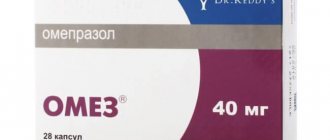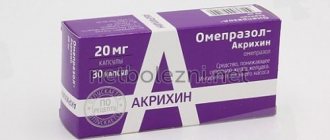Gastrozol®
The drug is taken orally, the capsules are not chewed, usually in the morning with a small amount of water (immediately before or during meals).
For patients with difficulty swallowing and for children who cannot swallow the capsule
Open the capsule and swallow the contents with 100 ml of warm water, or mix the contents of the capsule with an acidic liquid, such as apple juice or still water. Patients should be advised that the resulting dispersion solution should be taken immediately (within 30 minutes) and stirred immediately before use.
Adults
Duodenal ulcer
Patients with an active duodenal ulcer are recommended to take omeprazole 1 capsule (20 mg) once a day.
The drug provides rapid relief of symptoms. In most patients, ulcer healing occurs within 2 weeks. In cases where complete healing of the ulcer does not occur within 2 weeks, healing is achieved with a subsequent 2-week intake of the drug.
Patients with duodenal ulcers that are poorly responsive to treatment are usually prescribed omeprazole 40 mg (2 capsules) once a day; Ulcer healing usually occurs within 4 weeks.
To prevent relapses, patients with duodenal ulcers are recommended to take omeprazole 20 mg once a day. If necessary, the dose can be increased to 40 mg (2 capsules) 1 time per day.
Stomach ulcer
The recommended dose of omeprazole is 20 mg once a day.
The drug provides rapid relief of symptoms. In most patients, cure occurs within 4 weeks. In cases where healing does not occur after the first course of taking the drug, a repeat 4-week course is usually prescribed, during which healing is achieved.
Patients with stomach ulcers that are poorly responsive to treatment are usually prescribed omeprazole 40 mg (2 capsules) once a day; healing is usually achieved within 8 weeks.
To prevent relapses, a dose of 20 mg once daily is recommended for patients with gastric ulcers. If necessary, the dose can be increased to 40 mg 1 time per day.
NSAID-associated gastric ulcers or duodenal erosions
In the presence of NSAID-associated gastric, duodenal ulcers or gastroduodenal erosions in patients with discontinued or ongoing NSAID therapy, the recommended dose of omeprazole is 20 mg once daily.
The drug provides rapid relief of symptoms; in most patients, cure occurs within 4 weeks. In those patients who do not heal during the initial therapy period, healing is usually achieved with a 4-week repeat dosing.
For duodenal ulcers, erosions and symptoms of dyspepsia associated with taking NSAIDs, the recommended dose of the drug is 20 mg once a day.
Helicobacter pylori eradication regimens for peptic ulcer disease
Three-component treatment regimen:
- omeprazole 20 mg + amoxicillin 1000 mg + clarithromycin 500 mg 2 times a day in the morning and evening for 7 days;
- omeprazole 20 mg + metronidazole 400 mg (or tinidazole 500 mg) + clarithromycin 250 mg 2 times a day in the morning and evening for 7 days;
— omeprazole 40 mg (2 capsules) once a day + amoxicillin 500 mg 3 times a day + metronidazole 400 mg 3 times a day for 7 days.
Two-component treatment regimen:
- omeprazole 40-80 mg (2-4 capsules) + amoxicillin 1.5 g daily (the dose should be divided into parts) for 2 weeks.
To ensure complete healing, further treatment should be carried out in accordance with the recommendations in the sections “Duodenal Ulcer” and “Gastric Ulcer”.
In cases where, after completing a course of treatment, a test for Helicobacter pylori
remains positive, the course of treatment can be repeated.
Reflux esophagitis
The recommended dose of omeprazole is 20 mg once a day.
The drug provides rapid relief of symptoms; in most patients, cure occurs within 4 weeks. In cases where, after the first course of taking the drug, complete cure does not occur, a repeated 4-week course of treatment is usually prescribed, during which a cure is achieved.
For patients with severe reflux esophagitis, omeprazole 40 mg (2 capsules) 1 time per day is recommended; cure usually occurs within 8 weeks.
Patients with reflux esophagitis in remission are prescribed omeprazole 20 mg once a day as long-term courses of maintenance therapy. If necessary, the dose can be increased to 40 mg.
Symptomatic gastroesophageal reflux disease
The recommended dose of omeprazole is 20 mg once a day.
The drug provides rapid relief of symptoms. If after 4 weeks of treatment (20 mg 1 time per day) symptoms do not disappear, additional examination of the patient is recommended.
Dyspepsia associated with hyperacidity
To relieve pain and/or eliminate discomfort in the epigastric region, with or without heartburn, omeprazole is prescribed - 20 mg 1 time per day.
If after 4 weeks of treatment symptoms do not disappear, additional examination of the patient is recommended.
Zollinger-Ellison syndrome
For patients with Zollinger-Ellison syndrome, the drug is prescribed in an individual dosage. Treatment is continued according to clinical indications for as long as necessary.
The recommended starting dose of the drug is 60 mg (3 capsules) daily.
In all patients with severe forms of the disease, as well as in cases where other therapeutic methods did not lead to the desired result, the use of the drug was effective in more than 90% of patients when taking 20-120 mg of the drug daily.
In cases where the daily dose of the drug exceeds 80 mg (4 capsules), the dose should be divided into two parts and taken 2 capsules 2 times a day.
Renal dysfunction
In patients with impaired renal function, no dose adjustment is required.
Liver dysfunction
In patients with impaired liver function, the bioavailability and plasma half-life of omeprazole are increased. In this regard, a dose of 20 mg per day is sufficient.
Elderly patients (aged > 65 years)
In elderly people, no dose adjustment is required.
Children
Gastroesophageal reflux disease (GERD) in children over 2 years of age (body weight more than 20 kg)
20 mg 1 time per day.
If necessary, the dose can be increased to 40 mg (2 capsules) 1 time per day.
The duration of treatment for reflux esophagitis is 4-8 weeks.
The duration of treatment for the symptomatic treatment of heartburn and sour belching with GERD is 2-4 weeks.
If the symptoms of the disease do not disappear after using omeprazole for 2-4 weeks, further examination is recommended.
Duodenal ulcer associated with Helicobacter pylori (as part of combination therapy) in children over 4 years of age (body weight more than 31 kg)
For the purpose of eradication of Helicobacter pylori
in children over 4 years of age with duodenal ulcer, combination therapy is carried out taking into account national and regional recommendations regarding bacterial resistance (using appropriate antibacterial agents).
Omeprazole is prescribed 20 mg 2 times a day.
Duration of treatment is 7-14 days.
Gastrozol
Gastrozol ®
(lat.
Gastrozol ®
) is an antiulcer drug that reduces stomach acidity, a Russian generic of omeprazole.
Composition and release form of Gastrozol
Gastrozol release form:
opaque capsules No. 2.
The contents of the capsules are white to almost white pellets. Two dosage forms of Gastrozol are approved for use: enteric capsules 10 mg (white body, yellow cap) and 20 mg capsules (light pink body, pinkish-brown cap). Active substance Gastrozole
:
omeprazole (lat. omeprazole
). One capsule contains 10 or 20 mg of omeprazole.
Excipients of Gastrozol:
sodium lauryl sulfate, crystalline disodium phosphate, hydroxypropylcellulose, lactose, hydroxypropylmethylcellulose, corn starch, hydroxypropylmethylcellulose phthalate, sucrose. Or: mannitol, sucrose, sodium disubstituted phosphate, sodium lauryl sulfate, lactose, calcium carbonate, hypromellose, methacrylic acid copolymer L30D, propylene glycol, diethyl phthalate, cetyl alcohol, sodium hydroxide, polysorbate-80, povidone, titanium dioxide, talc.
Composition of the Gastrozol capsule:
iron oxide red, titanium dioxide, methylhydroxybenzoate, propylhydroxybenzoate, acetic acid, gelatin.
The most important advantage of Gastrozol is its low price
.
Indications for taking Gastrozol, order of administration and dose, contraindications, warnings, pharmacological properties, place among other proton pump inhibitors and other characteristics of Gastrozol are determined by its active substance omeprazole and are described in the article omeprazole
.
Professional medical publications concerning treatment of the gastrointestinal tract with Gastrozol
- Vertkin A.L., Zairatyants O.V., Vovk E.I. Continuity in the treatment of acid-related diseases of the stomach and duodenum in the compulsory health insurance system // Consilium Medicum. – 2005. – T. 7. – No. 2.
- Vasiliev Yu.V. Gastroesophageal reflux disease in the stage of reflux esophagitis: diagnosis and therapy // Farmateka. – 2004. – No. 13(90). - With. 1–5.
- Instructions for medical use of the drug Gastrozol (enteric capsules 10 mg), approved by the Ministry of Health of Russia on 01.08.17 (pdf, ).
On the website gastroscan.ru
in the literature catalog there is a section “Omeprazole”, containing medical articles concerning the treatment of diseases of the gastrointestinal tract with omeprazole preparations.
According to the pharmacological index, Gastrozol belongs to the group “Proton pump inhibitors”. For ATC - to the group “Proton pump inhibitors”, code A02BC01.
In Russia and other countries - former republics of the USSR, omeprazole is widely available in generic versions. Prices for generic omeprazole are much lower than prices for original drugs, such as Losek, Losek MAPS, which is important for many patients and often determines the choice of drug. Due to possible differences in the quality of drugs, an objective assessment of their clinical effectiveness is often necessary. Currently, 24-hour monitoring of intragastric acidity is an objective and accessible method for testing antisecretory agents in clinical practice (Alekseenko S.A.).
Gastrozol 10 mg is an over-the-counter drug.
The manufacturer of Gastrozol is Pharmstandard-Leksredstva OJSC, Kursk (previously produced in St. Petersburg).
Trade names of drugs with the active substance omeprazole
The following drugs are (were) registered in Russia: Bioprazole, Vero-Omeprazole, Demeprazole, Zhelkizol, Zerotsid, Zolser, Chrismel, Lomak, Losek, Losek MAPS, Omegast, Omez, Omez Insta, Omecaps, Omepar, Omeprazole, Omeprazole pellets, Omeprazole -AKOS, Omeprazole-Acri, Omeprazole-E.K., Omeprazole-Richter, Omeprazole Sandoz, Omeprazole-FPO, Omeprazole-OBL, Omeprazole-Teva, Omeprol, Omeprus, Omefez, Omizak, Omipix, Omitox, Ortanol, Otsid, Pepticum , Pleom-20, Promez, Risek, Romesek, Sopral, Ulzol, Ulkozol, Ultop, Helitsid, Helol, Cisagast.
A number of drugs with the active substance omeprazole that are not registered in Russia are presented on the pharmaceutical markets of the countries of the former republics of the USSR, in particular: Gasec, Losid, Omeprazole-Astrapharm, Omeprazole-Darnitsa, Omeprazole-KMP, Omeprazole-Lugal, Tserol and others.
A branded medicine with the active ingredient omeprazole on the US and Canadian markets is Prilosec (formerly called Losec). This brand is sold in Russia under the trademarks Losek Maps and Losek, in Germany, Italy and Switzerland - under the trademarks Antra and Antra MUPS. The over-the-counter version of Prilosec is Prilosec OTC.
Gastrozol has contraindications, side effects and application features; consultation with a specialist is necessary.
Back to section
Gastrozol®
Manufacturer: PHARMSTANDARD-LEKSREDSTVA JSC (Russia)
caps. 20 mg: 7, 10, 14, 20 or 28 pcs. Reg. No.: P N000770/01
Clinical and pharmacological group:
H+-K+-ATPase inhibitor. Antiulcer drug
Release form, composition and packaging
Capsules
opaque, hard gelatin, size No. 2, with a light pink body and a pinkish-brown cap; The contents of the capsules are pellets from white to almost white.
| 1 caps. | |
| omeprazole | 20 mg |
Excipients:
mannitol, sucrose, sodium lauryl sulfate, sodium hydrogen phosphate (disodium phosphate disubstituted), calcium carbonate, lactose, hypromellose (hydroxypropyl methylcellulose), methacrylic acid and ethyl acrylate copolymer (methacrylic acid copolymer L30D), propylene glycol, diethyl phthalate, cetyl alcohol, sodium hydroxide, polysorbate-80 (Tween-80), povidone (polyvinylpyrrolidone), titanium dioxide, talc.
Composition of the capsule shell:
iron oxide red (E172), titanium dioxide (E171), methyl parahydroxybenzoate (methylhydroxybenzoate), propyl parahydroxybenzoate (propylhydroxybenzoate), gelatin; or iron oxide red (E172), titanium dioxide (E171), gelatin.
7 pcs. — cellless contour packages (1) — cardboard packs. 7 pcs. — cellless contour packages (2) — cardboard packs. 10 pieces. — cellless contour packages (1) — cardboard packs. 10 pieces. — cellless contour packages (2) — cardboard packs. 10 pieces. — polymer jars (1) — cardboard packs. 14 pcs. — polymer jars (1) — cardboard packs. 28 pcs. — polymer jars (1) — cardboard packs.
Description of the active components of the drug "Gastrozol®"
pharmachologic effect
Antiulcer drug, inhibitor of H+-K+-ATPase (proton pump). Omeprazole reduces acid production - inhibits the activity of H+-K+-ATPase in the parietal cells of the stomach and thereby blocks the final stage of hydrochloric acid synthesis. The drug is a prodrug and is activated in the acidic environment of the secretory tubules of parietal cells.
Reduces the level of basal and stimulated secretion, regardless of the nature of the stimulus.
After taking the drug orally at a dose of 20 mg, the antisecretory effect develops within the first hour, maximum after 2 hours. Inhibition of 50% of maximum secretion continues for 24 hours.
Taking the drug once a day provides rapid and effective suppression of daytime and nighttime gastric secretion, reaching its maximum after 4 days of treatment and disappearing by the end of 3-4 days after stopping the drug. In patients with duodenal ulcer, taking the drug at a dose of 20 mg maintains the intragastric acidity level (pH) at level 3 for 17 hours.
Indications
- treatment of gastric and duodenal ulcers;
- prevention of relapses of gastric and duodenal ulcers;
- reflux esophagitis;
- hypersecretory conditions (Zollinger-Ellison syndrome, stress ulcers of the gastrointestinal tract, polyendocrine adenomatosis, systemic mastocytosis);
- NSAID gastropathy;
— for the purpose of eradication of Helicobacter pylori in infected patients with gastric and duodenal ulcers (as part of combination therapy).
Dosage regimen
The drug is taken orally, usually in the morning, the capsules are not chewed and washed down with a small amount of water (immediately before or during meals).
For duodenal ulcer in the acute phase
the drug is prescribed at a dose of 20 mg/day for 2-4 weeks; if the effectiveness is insufficient, the dose can be increased to 40 mg/day.
For gastric ulcers in the acute phase and erosive-ulcerative esophagitis
- 20-40 mg/day for 4-8 weeks.
For erosive and ulcerative lesions of the gastrointestinal tract caused by taking NSAIDs,
- 20 mg/day for 4-8 weeks.
For the purpose of eradication of Helicobacter pylori
prescribed 20 mg 2 times a day for 7 days in combination with antibacterial agents.
To prevent relapses of gastric and duodenal ulcers
- 20 mg/day.
To prevent relapses of reflux esophagitis
- 20 mg/day for a long time (up to 6 months).
For Zollinger-Ellison syndrome
the dose is set individually depending on the initial level of gastric secretion, usually starting from 60 mg/day. If necessary, the dose is increased to 80-120 mg/day, in which case it is divided into 2 doses.
Side effect
From the digestive system:
diarrhea or constipation, abdominal pain, nausea, vomiting, flatulence; rarely - increased activity of liver transaminases, taste disturbances, formation of gastric glandular cysts during long-term treatment (a consequence of inhibition of gastric hydrochloric acid secretion, is benign, reversible); in some cases - dry mouth, stomatitis; in patients with previous severe liver disease - hepatitis (including jaundice), impaired liver function.
From the hematopoietic system:
in some cases - leukopenia, thrombocytopenia, agranulocytosis, pancytopenia.
From the central nervous system and peripheral nervous system:
in patients with severe concomitant somatic diseases - dizziness, headache, agitation, depression; in patients with pre-existing severe liver disease - encephalopathy.
From the musculoskeletal system:
in some cases - arthralgia, myasthenia gravis, myalgia.
Dermatological reactions:
rarely - skin rash and/or itching; in some cases - photosensitivity, exudative erythema multiforme, alopecia.
Allergic reactions:
urticaria, angioedema, fever, bronchospasm, interstitial nephritis, anaphylactic shock.
Other:
rarely - gynecomastia, malaise, blurred vision, peripheral edema, increased sweating.
Contraindications
- pregnancy;
- lactation period (breastfeeding);
- childhood;
- hypersensitivity to the drug.
Carefully _
the drug should be used for renal and/or liver failure.
Pregnancy and lactation
The drug is contraindicated for use during pregnancy and lactation (breastfeeding).
Use for liver dysfunction
The drug should be used with caution in patients with liver failure.
Use for renal impairment
The drug should be used with caution in patients with renal failure.
Application for children
Contraindicated: children's age.
special instructions
Before starting treatment, it is necessary to exclude the presence of a malignant process (especially with gastric ulcer), because taking Gastrozol may mask symptoms and delay the correct diagnosis.
Taking the drug simultaneously with food does not affect its effectiveness.
Overdose
Symptoms:
confusion, blurred vision, drowsiness, dry mouth, headache, nausea, tachycardia, arrhythmia.
Treatment:
carrying out symptomatic therapy. Hemodialysis is not effective enough.
Drug interactions
Gastrozole may reduce the absorption of ampicillin esters, iron salts, itraconazole and ketoconazole, because Omeprazole increases the pH of the stomach.
As an inhibitor of isoenzymes of the cytochrome P450 system, omeprazole can increase plasma concentrations and reduce the excretion of diazepam, indirect anticoagulants, phenytoin (drugs metabolized in the liver with the participation of CYP2C19), which in some cases may require a reduction in the doses of these drugs.
With long-term use of omeprazole at a dose of 20 mg 1 time / day in combination with caffeine, theophylline, piroxicam, diclofenac, naproxen, metoprolol, propranol, ethanolol, cyclosporine, quinidine and estradiol did not lead to a change in their plasma concentrations.
Gastrozole enhances the inhibitory effect of other drugs on the hematopoietic system.
There was no interaction between omeprazole and concomitantly taken antacids.
Conditions for dispensing from pharmacies
The drug is available with a prescription.
Storage conditions and periods
List B. The drug should be stored out of the reach of children, in a dry place, protected from light at a temperature not exceeding 25°C. Shelf life: 3 years.
Drug interactions
Gastrozole may reduce the absorption of ampicillin esters, iron salts, itraconazole and ketoconazole, because Omeprazole increases the pH of the stomach.
As an inhibitor of isoenzymes of the cytochrome P450 system, omeprazole can increase plasma concentrations and reduce the excretion of diazepam, indirect anticoagulants, phenytoin (drugs metabolized in the liver with the participation of CYP2C19), which in some cases may require a reduction in the doses of these drugs.
With long-term use of omeprazole at a dose of 20 mg 1 time / day in combination with caffeine, theophylline, piroxicam, diclofenac, naproxen, metoprolol, propranol, ethanolol, cyclosporine, quinidine and estradiol did not lead to a change in their plasma concentrations.
Gastrozole enhances the inhibitory effect of other drugs on the hematopoietic system.
There was no interaction between omeprazole and concomitantly taken antacids.


